 |
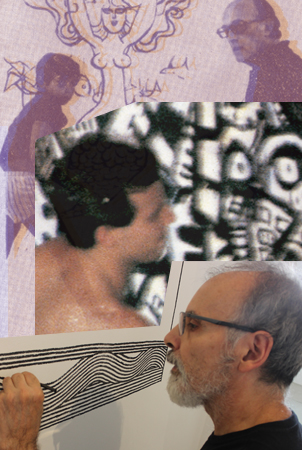 | "BIO" Jaime Prades is Brazilian, born in Spain. He is the son of South Americans: a Brazilian mother and a Uruguayan father. He lived between Málaga and Madrid until the age of 12 when his family returned to Brazil. Since his father worked in the film industry, he spent his childhood surrounded by artists and in their studios. Among them, Antonio Mingote was the most important. With him, Jaime had the opportunity to spend many summers in the vicinity of San Pedro de Alcantara in Andalusia... (CLICK TO OPEN) |
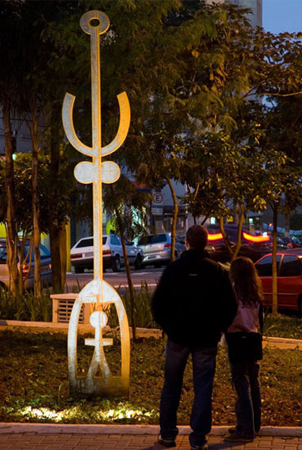 | "THE ART OF JAIME PRADES" By FÁBIO MAGALHÃES: "Jaime Prades, art in context":
From a tender age, Jaime Prades adopted experimentation as a creative attitude, always striving to diversify his means of expression, which are not limited to painting. His projects crossed the barriers ordained by modernity, and since the ‘80s his restlessness has driven him to pursue untraveled paths, pointing to new horizons.
Many of his innovative ideas were shared by German group Fluxus (flux is the Latin word for catharsis), which revolutionized the concept of art in the 1960s and 1970s, deeply influencing later generations. The work of Joseph Beuys causes immense impact even today. It is worth noting that at the same time the Fluxus group was stirring the European artistic scene, a new concept of art was also being developed in Brazil. Lygia Clark and her “Bichos” (“Beasts”), and Helio Oiticica and his “Parangolés” are just two examples of artists who brought about irreversible changes to the Brazilian artistic production, and who are today internationally renowned for their great contribution to world vanguard. (CLICK TO OPEN) |
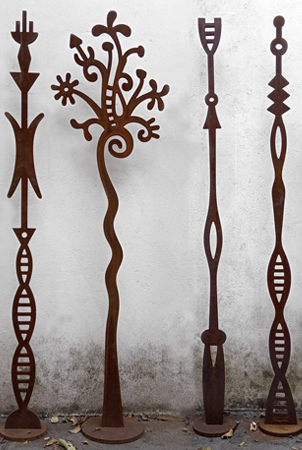 | "ROOTS AND STARS" From the depths of the earth to infinite space
by JAIME PRADES
"Arrows," "Points," "Needles," and, most notably: "Totems" are some of the names that this series of sculptures could bear.
Loaded with ancestry, they carry a fragrance of vernacular expressions from indigenous and African traditions, not only from South American Amerindian nations.
It's a universal language that is confirmed by the intimacy that occurs immediately upon contemplating them.
They also carry a ritualistic memory, predating religions, still in a state of communion with the nature of the time when the mystery of life and death shaped social relationships.
The Totem in its essence emerges as a living symbol between the cosmic and the earthly, between the sky and the earth, between spirit and body.
Encompassing so many symbolic layers, this structuring form of the psyche establishes a connection between the human and its divine dimension. Through its verticality, the possibility of interdimensional transit is established.
The installation "Roots and Stars" refers precisely to this mystery that survives beyond time.
(CLICK TO OPEN) |
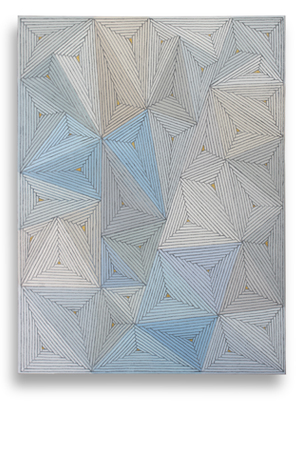 | "CRISTAL" It looks like a crystal studded with diamonds. Pigments, graphite, the mineral kingdom, ground earth, powdered color. Stone, color, powder. The linseed oil, that goo, that fluid, tree blood, vegetable kingdom. I work as if I were a mason plastering a wall. Spatula is my instrument. I tear this treacherous, slippery layer of mass with the point of the pencil. Each line is a game of forces, a train ready to derail. At times I even shout for the line to obey a route without a guide. I think as a risk: "don't think!"... In the end, after hours of skating in that mayonnaise, smeared with paint and graphite, I know that in a few days when the paint oxidizes and turns matte, the gesture will be shaped, time suspended. I gave up asking myself if it's painting, drawing, engraving. I think it must be all mixed up like a big pataphysical party. I've been thinking that we artists are and form a great forest. Where each of us is like an original tree. We grow fueled by the power of diversity and the energy of experimentation. A laboratory where consciousness can play at evolving. Art anticipates what is latent in gestation. Borges, Jorge Luís, said that everything that happens to the artist, in joy or tragedy, is material to be transformed into eternity. (CLICK TO OPEN) |
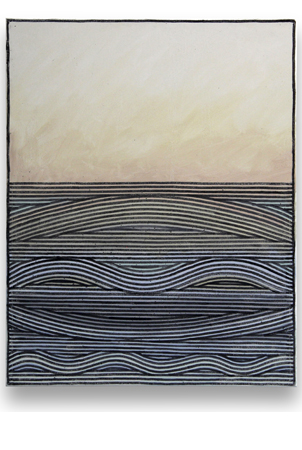 | "UTOPICS" I recently said in a conversation that my studio is a laboratory. The idea that images are born from experiments carries another idea: that they happen, catalyze, reveal themselves. It is not by chance that I need to use chemistry jargon to try to convey the creative process. Using a minimum of resources (in this case oil paints and charcoal) further enhances the clash in the face of surprise. Daring to throw yourself into this void, where no reference to reality exists to support yourself, is my great adventure. (CLICK TO OPEN) |
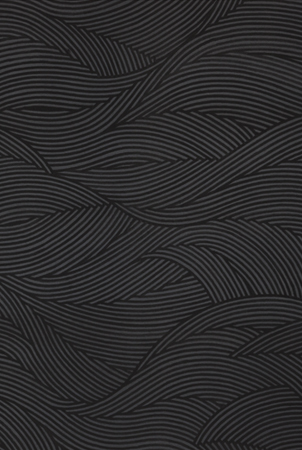 | "BEYOND THE MOVEMENT" By ANA AVELAR: "Although Prades’ current paintings may visually evoke Stella’s due to their graphism and flatness just as Stella’s 1960s paintings were associated to Vasarely’s, the issues that drive them are entirely different. Whereas in Stella we see the literality of patterns and in Vasarely we see his fascination for the possibilities of the visual perception of movement, Prades is interested in the trance established by relative repetition, like in a mantra. Through continuity as well as through an attentive, long lasting and patient work, this experience seeks to offer a door to contemplation through a curvilinear and sensual shape.
By the way, this graphism, which is simultaneously a grid and not a grid, together with the irregularities of the hand and a silent palette, conceptually speaking, brings to mind the work of Agnes Martin, a Canadian painter who lived in the USA. Although Martin’s paintings are created using washed-out hues, and includes grids or stripes – they also blur the limits between drawing and painting –, the effect of these works is similar to the effects of Prades’ current paintings, which were created with no previous project and through the application of charcoal directly on the canvas (a line that is “done when is being drawn,” according to Prades)."
(CLICK TO OPEN) |
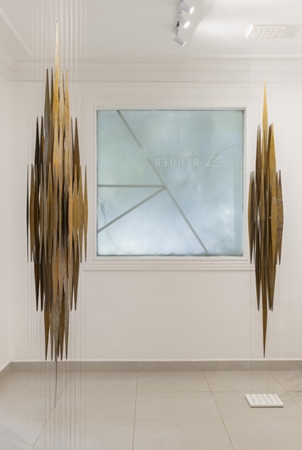 | "CARVÃO ÓLEO FERRO" This exhibition brings together the three techniques and languages that I have been researching all my life: drawing, painting and sculpture. I could say: line, light and space, tracing this equivalence since human expressions act in different layers of consciousness and its material manifestations.
Art works with the creative processes of languages and the ways in which they are embodied. This transit between consciousness and matter implies a chemical and alchemical process where the many intelligences that make up us as individuals in this phenomenon of life, cooperatively act, through their talents, to materialize.
Just as we learned through the rescue of traditional wisdom that there is an intelligence of the heart, I dare to say that all the senses are manifestations of intelligence. There is intelligence in the hands, eyes, hearing... Going further, there is intelligence in the skin, in the body in motion, in each organ in its activity. The idea that the brain is the control center is perhaps reductionist and not very poetic.
Our skills, the many ways of feeling, intuitions, escape the control of a vision that perhaps reproduces the hierarchy that, drawing a parallel, exists in the power structures of monotheism, of monarchies and of all the organizations that are structured from of a pyramidal order.
It is not up to me to play the role of a scientist. As an artist, I learn by doing, by experience. The ever-changing language is the evolutionary manifestation of consciousness. If around 30,000 years ago we found records of rock inscriptions – today we know that they happened simultaneously in different places on the planet – we can say that there was a birth of language that manifested a leap in consciousness and vice versa. In Werner Herzog's film “The Cave of Forgotten Dreams”, this mystery is probed as the mechanical eyes of the camera lens penetrate deeper and deeper into the Chauvet cave in southern France.
Observing contemporary artistic processes helps us to perceive the fermentation of evolutionary processes that are taking place in this world in saturation. It helps us to prepare and exercise our plasticities capacities in the physical, mental, emotional and spiritual bodies that define us as human beings.
It is clear to me that we are facing irrevocable evolutionary pressure. Faced with environmental bankruptcy at a planetary level, the need to deconstruct prejudiced structures of race, gender, class, practically implies reviewing all of our civilizing structures.
It's about reinventing the world!
Drawing, painting and sculpture are experimental territories where the exercise of transformation manifests itself. Where balance happens because the point of gravity changes at all times. This permanent movement rocks the music of the spheres. Balance is impermanence. Exercising creativity is not just a pain reliever. The artist dares to delve into his inner abyss and bring to the world, transformed into a work, what speaks in him.
As Anselm Kiefer said: art is not entertainment.
Just as I am the curator of my own exhibition, legitimized by more than 45 years of experience and I live as I am, I also allow myself to bring up this text that escapes the conventional structures of exhibition presentation.
What I write here is part of the many thoughts I have at this point in my life. Questions that pervade my daily life where I dedicate myself daily to making art. I dedicate myself to thinking and producing language in the cave-atelier where, thanks to the solitude, I manage to feel in communion with myself, with society and with nature.
There is, in my option for art, an anti-systemic attitude. In the sense of prioritizing craft practices that depend on the intelligence of the hands, on the skills of the body. The work is like an extension of my body and spirit, almost an external organ. I prioritize simplicity and face the challenge of doing the most with the least amount of resources.
COAL OIL IRON takes place in this context.
I hope it's helpful.
Thank you very much!
Jaime Prades
March 24, 2023 (CLICK TO OPEN) |
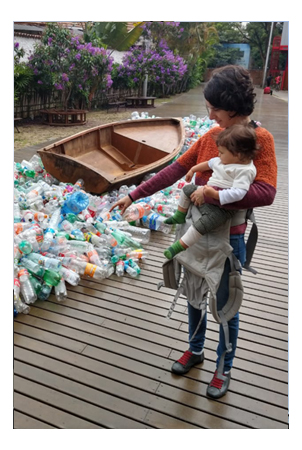 | "ADRIFTH" The installation "à Deriva", revisited and adapted, was inaugurated on March 3, 2020 on the external deck of SESC Pompéia in the city of São Paulo. It was interrupted 15 days after the inauguration due to the closure of SESC / SP units due to the pandemic. (CLICK TO OPEN) |
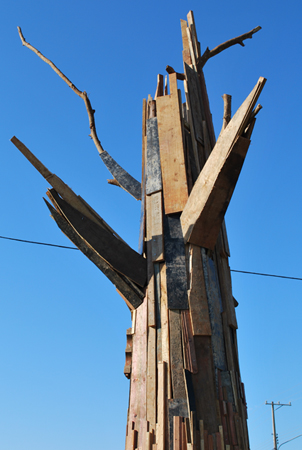 | "HUMAN NATURE" FÁBIO MAGALHÃES: But I think your art is bigger than that, that although it includes these concepts, these anxieties, it alludes to something that goes way beyond ecological concerns. I think it deals with deeper issues. It discusses, in a very encompassing way, the issue of life and death. And it creates a very strong link between culture and nature, between human life and its connection to the natural environment. There are a lot of people fighting for ecology, and you are one of them, but at the same time you create a work that surpasses this discourse. Your poetry reaches other levels and other spheres of the human being, bringing perplexity of the destructive power, the perversity of our society. That is what touches me in this work of yours.
JP: That is true, what really makes me move is not a purely ecological discourse. The issue for me is that right now we need to create signs that somehow allow us to interrupt this collective hypnosis. We need to wake up and shudder.
FM: Frans Krajcberg has been dealing with that in an intense and incisive way. And he operates with aesthetic elements from the modernity. But this work of yours has greater impact, is more aggressive. Krajcberg turns to nature in itself, dramatizing this issue; while you turn to nature from a human perspective; your tree discusses our culture, our eschatology, our life and our death. And that is why this work had such an impact on me. (CLICK TO OPEN) |
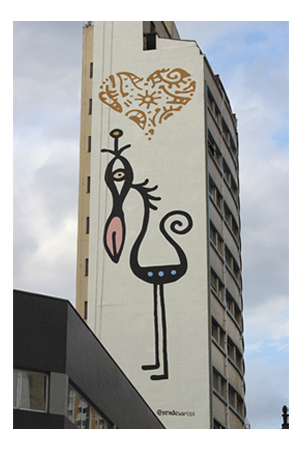 | "AVE PINDORAMA" Left side wall, DOGAL building, Avenida Duque de Caxias 609, city of São Paulo, São Paulo, Brazil, Latin America, planet Earth!
She, AVE PINDORAMA was able to go there! It should stay for a good few years during which it will wear out from the weather. Enough time to become part of the memory and visual repertoire of an entire generation of the city. (CLICK TO OPEN) |
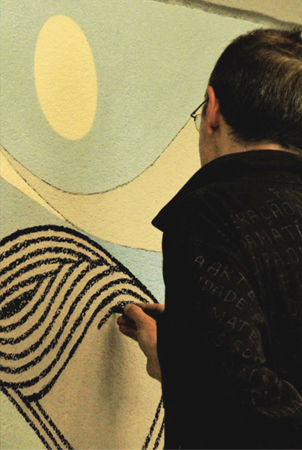 | "CÉU E TERRA" The pulsing painting of Prades seduces us and makes our eyes wander smoothly along its shapes and, like the chant of sirens – and their undulating hair –, we must allow ourselves to be seduced because we do not fear the bottom of the sea to which we will certainly be taken. As Klee said, "Let yourself be carried on the invigorating sea, on a broad river or an enchanting brook, such as that of the richly diversified aphoristic graphic art".
Ana Avelar curator (CLICK TO OPEN) |
HIGHLIGHTS
|
|
